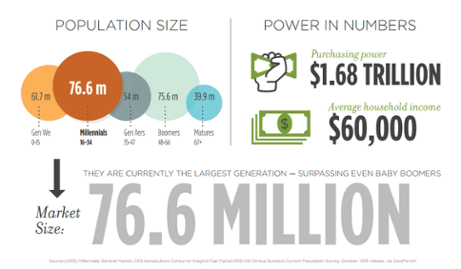We are in the midst of a huge shift in buying power. With a purchasing power of $1.68 trillion, Millennials are poised over the next few years to become the predominant force in the furniture industry. But don’t expect Millennials to shop for furniture the same way their parents did. Millennials are pushing for disruption to the old model, forcing retailers to re-evaluate their strategy and create a customized, innovative experience for them. In order to compete, traditional furniture retailers will need to understand the lifestyle and behaviors of this increasingly influential segment and find innovative ways to earn their business.

Millennials grew up in a period of economic turmoil—between 9/11, the Great Recession and student loan debt—this generation is experiencing a less than traditional foray into adulthood. Additionally, growing up with technology, they’ve become accustomed to a quick and convenient lifestyle, which also applies to how they approach commerce. They’ve come to expect a certain level of experience from retailers, and if it’s not met, they’ll pass you over quickly for the next retailer that satisfies their needs. With this in mind, let’s look at what traditional furniture retailers like you need to do to speak the Millennial language.
Understand Their Values
One of the most prominent differences between Millennials and their predecessors is their value set and how it relates to the products they purchase. While previous generations placed strong value on traditions, duty, practicality, etc., Millennials place much more emphasis on experiential values such as happiness, passion and discovery.
Furniture retailers that market to consumers based on traditional life stages such as getting married, buying a new home, etc. may miss the mark on the Millennial generation who have taken a longer or more distorted path to adulthood than their parents. Additionally, marketing products based on style or price doesn’t resonate with this group. Where the Boomers valued luxury and brand names, Millennials are much more attune to marketing tactics and place more emphasis on substance and quality of the product as well as the shopping experience.
Personalize the Experience for Them
After seeing a strong trend that Millennials are not “lovin” what they offer, McDonald’s has been trying new, innovative ways to target the Millennial consumer. Millennials do not want the same cookie-cutter hamburger that was served to their parents and grandparents for generations. They want something personal; an enjoyable experience that makes them feel good, inside and out. As a result, McDonald’s is utilizing technology to create a modern experience personalized for the customer through their ‘Build Your Burger’ Program. Customers place orders in the restaurant using a tablet to select exactly what kind of burger they want, down to the type of bun and fixings.
If McDonald’s is changing their 60-year-old hamburger for Millennials, it is time for furniture retailers to do the same to stay relevant to this powerful consumer base. Retailers need to not only allow a variety of furniture options for their customer, but allow them to shop through the channels they choose to shop and personalize that experience for each individual. The furniture retailers that create a modern shopping experience marrying both online and in-store channels will be the ones who succeed in this category.
Offer Financing Online and In-Store
In a study of more than 2,000 consumers, 59% of Millennial shoppers say their choice of retailer is impacted based on whether that retailer offers financing. Additionally, in a recent study by Experian, the average consumer between the ages of 19 and 29 has a credit score of just 628 and is $23,332 in debt. This is significantly lower compared to Baby Boomers who have an average credit score of 700 and the Greatest Generation with a credit score of 735. Needless to say, financing will be a huge factor for Millennials purchasing big-ticket items such as furniture. And for this consumer base who does not discriminate against “channels” it is imperative you make financing options available on whatever channel they choose to shop with you.
Before you even begin to start catering to Millennials, it is important to ensure you have the backbone of ecommerce technology in place. When looking for a platform it is important to consider how you can improve the individual experience for each user on the back end through segmentation capabilities, the ability to offer a variety of financing options such as a branded credit card as well as rent-to-own, and a team of ecommerce experts well versed in furniture that can guide you on how to engage this new generation of furniture shoppers.




